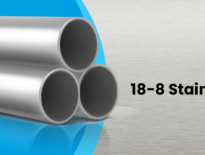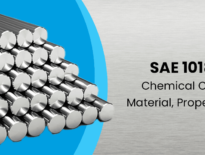What is Stainless Steel 316?
Stainless Steel 316 is a premium austenitic stainless steel that combines 16-18% chromium, 10-14% nickel, and 2-3% molybdenum with smaller amounts of carbon, manganese, phosphorus, sulfur, silicon, and nitrogen. This blend gives it exceptional properties, making it a top choice for many demanding applications.
One of the standout features of Stainless Steel 316 is its outstanding corrosion and oxidation resistance. It is specifically designed to handle harsh environments, including chemical processing and marine applications, where resistance to rust and degradation is crucial.
In addition to its corrosion resistance, Stainless Steel 316 is known for its strength and durability. It performs well under high temperatures and is easy to fabricate, which makes it suitable for various construction and architectural uses like handrails, supports, and decorative elements.
Overall, Stainless Steel 316 is a versatile material. Its combination of high performance and resilience makes it a reliable choice for a wide range of industrial, commercial, and residential applications. Whether for medical devices, food processing equipment, or structural supports, Stainless Steel 316 meets the highest standards of quality and reliability.
Density of Stainless Steel 316
The density of Stainless Steel 316 is approximately 8.0 g/cm³ (grams per cubic centimeter) or 0.289 lb/in³ (pounds per cubic inch). This density can vary slightly depending on the specific composition and the manufacturing process used for the stainless steel.
At standard room temperature and atmospheric pressure, 316 stainless steel maintains a consistent density. However, it’s worth noting that factors such as temperature, pressure, and mechanical stress can slightly alter this density.
High density contributes to the strength and durability of Stainless Steel 316. This characteristic, along with its corrosion resistance, makes it a preferred material for various industrial, commercial, and residential uses. Stainless Steel 316’s density ensures it performs well under demanding conditions, from chemical processing to structural applications.
Because of its combination of high density, strength, and corrosion resistance, Stainless Steel 316 is commonly used in environments where these properties are crucial, such as in marine applications, medical devices, and food processing equipment.
Stainless Steel – Grade 316 (UNS S31600)
| Material: | Stainless Steel – Grade 316 (UNS S31600) |
| Composition: | Fe/<.03C/16-18.5Cr/10-14Ni/2-3Mo/<2Mn/<1Si/<.045P/<.03S |
| Property | Minimum Value (S.I.) | Maximum Value (S.I.) | Units (S.I.) | Minimum Value (Imp.) | Maximum Value (Imp.) | Units (Imp.) |
|---|---|---|---|---|---|---|
| Atomic Volume (average) | 0.0069 | 0.0072 | m3/kmol | 421.064 | 439.371 | in3/kmol |
| Density | 7.87 | 8.07 | Mg/m3 | 491.308 | 503.794 | lb/ft3 |
| Energy Content | 91 | 111 | MJ/kg | 9858.82 | 12025.6 | kcal/lb |
| Bulk Modulus | 134 | 152 | GPa | 19.435 | 22.0457 | 106 psi |
| Compressive Strength | 170 | 310 | MPa | 24.6564 | 44.9617 | ksi |
| Ductility | 0.3 | 0.51 | 0.3 | 0.51 | NULL | |
| Elastic Limit | 170 | 310 | MPa | 24.6564 | 44.9617 | ksi |
| Endurance Limit | 256 | 307 | MPa | 37.1296 | 44.5265 | ksi |
| Fracture Toughness | 112 | 278 | MPa.m1/2 | 101.925 | 252.993 | ksi.in1/2 |
| Hardness | 1700 | 2200 | MPa | 246.564 | 319.083 | ksi |
| Loss Coefficient | 0.00095 | 0.00148 | 0.00095 | 0.00148 | NULL | |
| Modulus of Rupture | 170 | 310 | MPa | 24.6564 | 44.9617 | ksi |
| Poisson’s Ratio | 0.265 | 0.275 | 0.265 | 0.275 | NULL | |
| Shear Modulus | 74 | 82 | GPa | 10.7328 | 11.8931 | 106 psi |
| Tensile Strength | 480 | 620 | MPa | 69.6181 | 89.9234 | ksi |
| Young’s Modulus | 190 | 205 | GPa | 27.5572 | 29.7327 | 106 psi |
| Glass Temperature | K | °F | ||||
| Latent Heat of Fusion | 260 | 285 | kJ/kg | 111.779 | 122.527 | BTU/lb |
| Maximum Service Temperature | 1023 | 1198 | K | 1381.73 | 1696.73 | °F |
| Melting Point | 1648 | 1673 | K | 2506.73 | 2551.73 | °F |
| Minimum Service Temperature | 0 | 0 | K | -459.67 | -459.67 | °F |
| Specific Heat | 490 | 530 | J/kg.K | 0.379191 | 0.410145 | BTU/lb.F |
| Thermal Conductivity | 13 | 17 | W/m.K | 24.3364 | 31.8246 | BTU.ft/h.ft2.F |
| Thermal Expansion | 15 | 18 | 10-6/K | 27 | 32.4 | 10-6/°F |
| Breakdown Potential | MV/m | V/mil | ||||
| Dielectric Constant | NULL | |||||
| Resistivity | 69 | 81 | 10-8 ohm.m | 69 | 81 | 10-8 ohm.m |
Chemical Composition of Density of ss316
| Element | 316 |
| Carbon | 0.08 |
| Chromium | 16.0-18.0 |
| Nickel | 10.0-14.0 |
| Molybdenum | 2.00-3.00 |
| Manganese | 2.00 |
| Silicon | 0.75 |
| Nitrogen | 0.10 |
| Phosphorus | 0.045 |
| Sulfur | 0.030 |
Mechanical Properties of Density of 316 Stainless Steel
| Property | 316 |
| Yield Strength, min. (ksi) | 30 |
| Tensile Strength, min. (ksi) | 75 |
| Elongation, min. (%) | 40 |
| Hardness, max. (Rb) | 95 |
Environmental Properties of Stainless Steel 316
| Resistance Factors 1=Poor 5=Excellent |
|
|---|---|
| Flammability | 5 |
| Fresh Water | 5 |
| Organic Solvents | 5 |
| Oxidation at 500C | 5 |
| Sea Water | 5 |
| Strong Acid | 5 |
| Strong Alkalis | 5 |
| UV | 5 |
| Wear | 4 |
| Weak Acid | 5 |
| Weak Alkalis | 5 |
Conclusion
In summary, stainless steel 316 is a durable and corrosion-resistant austenitic stainless steel, featuring 16-18% chromium, 10-14% nickel, and 2-3% molybdenum. With a density of about 8.0 g/cm³ (0.289 lb/in³), it offers excellent strength and longevity. This makes stainless steel 316 a versatile material suitable for a wide range of industrial, commercial, and residential applications.
FAQs
What is the density of SS 316 in kg m3?
The density of SS 316 stainless steel is approximately 7980 kg/m³.
What is the bulk density of 316 stainless steel?
The bulk density of 316 stainless steel is approximately 8.0 g/cm³ or 0.289 lb/in³.This density indicates its strength, durability, and corrosion resistance, making it suitable for a wide range of applications.
What does 316 mean in stainless steel?
316 in stainless steel signifies a grade with 16-18% chromium, 10-14% nickel, 2-3% molybdenum, and a small percentage of carbon. The molybdenum enhances corrosion resistance, making it superior to other stainless steel grades.


